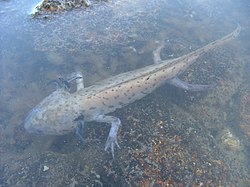
There are a wide range of frogs, salamanders and caecilians that can be kept a pets in an aquarium. Many of these are not found in the pet trade. This is usually because they're either too big for most commercial aquariums (ex: giant salamanders), endangered (ex: achoques), haven't entered the pet trade yet, or a mix of the three.
Contents
- Frogs (Order Anura)
- Pipidae
- Telmatobiidae
- Salamanders (Order Urodela)
- Giant salamanders (Cryptobranchidae)
- Sirens (Sirenidae)
- Newts (Pleurodelinae)
- Tiger salamanders (Ambystomatidae)
- Proteidae
- Amphiumas (Amphiumidae)
- Caecilians (Order Gymnophiona)
- Aquatic caecilians (Typhlonectidae)
- See also
- Footnotes
- Notes
- References
All animals on this list are fully aquatic, meaning they can live without access to land. However, many still need breath air, as they lack gills in their adult phase.








































